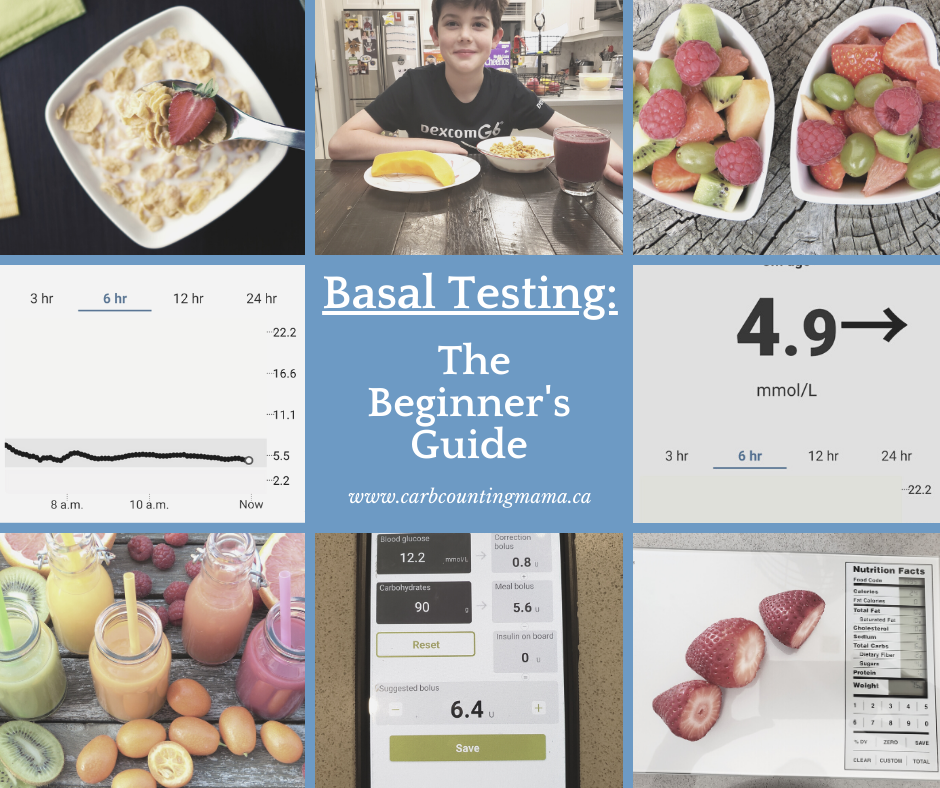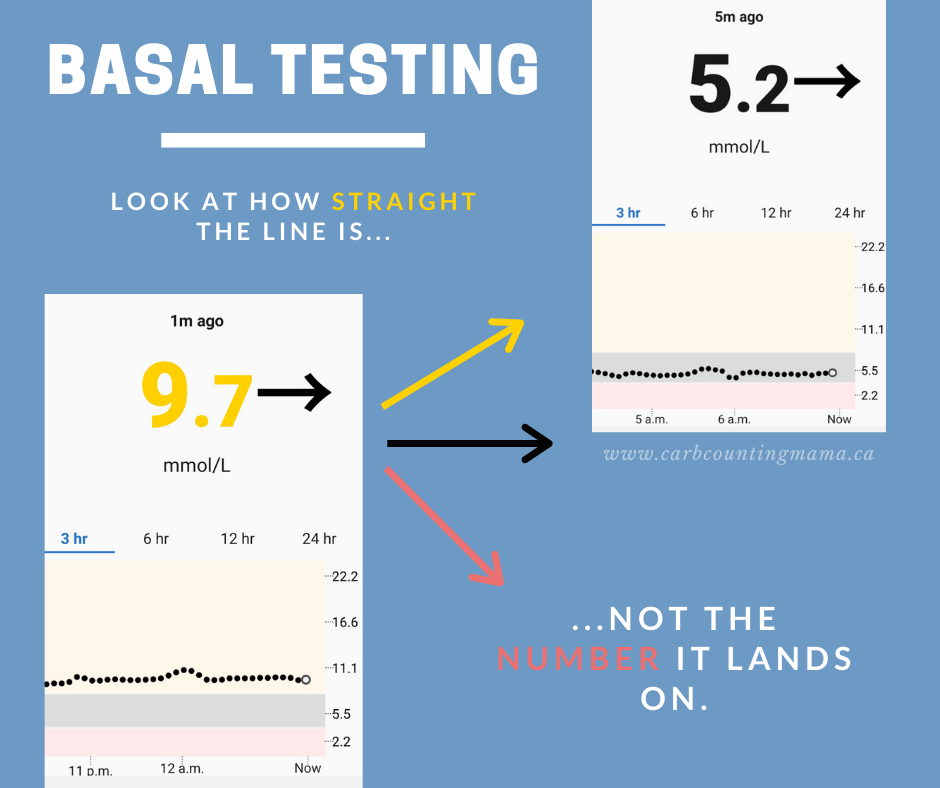Adjusting insulin levels can be confusing and overwhelming. Often, you can see that something needs to be changed, but it’s hard to tell what needs to be adjusted. And there’s no shortage of conflicting information out there to add to the confusion.
In this easy to follow guide, I’ll explain the role basal plays in T1D management, how to test its accuracy, and go over exactly how to determine whether or not you need to make basal rate adjustments. Here’s everything you need to know about basal testing.

This post contains affiliate links
I am not a doctor or medical professional. This article is for informational purposes only. If you are thinking about changing the way you treat your diabetes, consult your medical team for assistance.
A quick note before we start:
Basal insulin is used differently with looping systems. That’s where the insulin pump and CGM “talk” to each other and make adjustments without user input. This form of basal testing is not recommended if you’re looping.
What is basal testing?
Basal testing is actually pretty simple. But most people with T1D are not taught how to do it. That’s because a lot of medical professionals, including endocrinologists, are not familiar with basal testing or how it works.
It’s a concrete way to figure out if your basal rate is accurate or if it needs to be adjusted.
Why is that important?
Basal is the foundation of your T1D management. If your basal rate is correct, it’s a lot easier to figure out bolusing for things like large meals, unusual activity, and even hormone fluctuations.
If your basal rate is too high or too low, it will mask other problems. It might look like your ratios or sensitivity factors are not working properly even if they are. It’s extremely difficult to figure out cause and effect if your foundation is not solid.
Setting up the ideal conditions for a basal test
The first step to basal testing is making a plan. You’re a scientist conducting an experiment. You need certain conditions for an accurate basal test.
Setting up these conditions is as easy as “1, 2, 3”.
These are the 3 main things that will affect a basal test:
- Food
- Insulin
- Exercise
1. Food
Basal insulin is not meant to cover food. If you are still digesting your last snack or meal, it’s not a true basal test. And we aren’t just talking about carbs. Approximately 50% of protein and 10-15% of fat break down into glucose in the body. And fat often causes insulin resistance for 10+ hours after eating.
That is why you want to avoid fat and protein during a basal test. If you’re able to fast completely, that’s the best time to do a basal test. But, if you have a child who can’t easily skip a meal or two, the next best thing to do is have an early dinner that is high carb and low fat and protein. And I mean LOW. Less than 5g combined if you can.
Here’s Jordan’s dinner for one of his basal tests:

A cup of cereal with half a cup of almond milk, a fruit smoothie (frozen berries, a banana, and half a cup of almond milk), and cantaloupe.
We use our Perfect Portions Scale to measure Jordan’s food. It gives you all of the nutritional information you need right on the scale. That way, we can accurately dose for the carbs which helps to set the stage for the overnight basal test.
Eat the low p/f dinner and dose for the carbs accordingly. Because carbs are “quick in, quick out”, both the bolus insulin and the food will be out of your system a few hours after eating. At that point, you can observe what your basal insulin is doing.
2. Insulin
Your IOB has to be zero. The idea is to isolate the basal, so the last bolus for your meal, snack, or high correction has to be out of your system.
Overnight testing is best. It’s the longest stretch of time that most people fast.
Because my son is currently MDI, his overnight basal test will be the same as during the day. There’s no way around that. But even when he was using an insulin pump, we often preferred to have one basal rate set throughout the day.
If you use an insulin pump, ideally you should have only 1 or 2 basal rates for the entire day. I know that’s counter-intuitive, but multiple basal rates often cause more roller-coaster numbers than they solve. If you have multiple rates, you can easily change them to one by adding up your total daily basal and dividing it by 24 hours. Simple as it may sound, you should probably talk to your diabetes team before making a change like this.
If you feel that you need multiple basal rates, you should set up multiple basal tests so that you can test each basal rate that you have programmed.
3. Exercise
Different amounts of exercise can cause us to become insulin resistant or more sensitive to insulin. The effects of exercise can last up to 24 hours, so if you’ve been particularly active or inactive during the day, it’s not a good time to basal test.
Find a day that you have done your average amount of exercise. If you usually play video games and binge Netflix all day, basal test on a day where you haven’t been very active. If you usually play sports or go running or hiking, do it on a day that you’ve done those things. You want to figure out the best basal rate for your day to day life, so whatever is normal for you is the goal.
Let’s do a quick recap:
- Food. Try to fast prior to basal testing. If you have to eat, make sure your meal or snack is low fat, and low protein.
- Insulin. Make sure all bolus insulin is out of your system during a basal test.
- Exercise. Plan your basal test on a day that your activity level has been normal for you.
Now that you’ve got the right conditions, it’s time to basal test
This is the easy part. Skip dinner (or eat an early, high-carb, low p/f dinner… make sure you bolus appropriately for the carbs) and watch your numbers.
If you’ve eaten dinner, it will be a few hours before you can start watching the basal. If you have a CGM or FGM, simply watch the graph. With finger pokes, you’ll have to do manual blood sugar checks frequently throughout the night to get a good idea of what is happening. Every hour or two would be best.
Do your best not to treat highs or lows during a basal test. If you have to use insulin or eat glucose, the basal test won’t work and you’ll have to try again another time. Of course, don’t put yourself in a dangerous situation. But if you’re a little bit out of the range you normally like, consider leaving it just for the night so that you can get an accurate idea of what your basal is doing.
What you’re looking for when basal testing
I can’t just tell you to watch your numbers without explaining what we’re looking for. First, let’s talk about basal insulin’s job.
The purpose of basal insulin
Basal insulin has one job. It is the insulin that should keep your blood glucose numbers steady in the absence of food, activity, and bolus insulin.
It keeps your body functional. Even if you are doing absolutely nothing, laying in bed all day every day, you need a certain number of calories to burn so that your organs keep working. You need to get glucose to your cells and brain. That is what basal insulin does.
It is the “background” insulin. Its job is NOT to push down or pull up your bg.
So, if you’ve ever thought, “My child starts the night at 14 (252), but by morning it’s down to 5.2 (94). They’re waking up in range, that means their basal is working.”
No. That means their basal is way too strong. It should not be bringing your child’s blood glucose down overnight. If your basal is accurate, you should be able to skip meals or fast for several hours without having to worry about your glucose levels dropping or rising.
3 main outcomes
What you should see by the morning is some sort of line. It’s either straight, trending down, or trending up as the night progresses.
- Straight: It doesn’t have to be PERFECTLY straight. If the overnight line stays around the same number throughout the night that means your basal rate is exactly where it should be. If you get this result, but your numbers have been wonky, you might want to move on to figuring out pre-bolusing or adjusting your carb ratio. Basal is not the cause of your roller coaster.
- Trending down: This means your basal is too heavy. It’s pulling your blood glucose down and that’s not what you want. Depending on how much it’s dropping overnight, you likely will want to give less basal moving forward. This is the most common result as many endos use basal to cover fat and protein as well as “free” snacks.
- Trending up: This means you aren’t getting enough basal. In this case, you’ll want to increase the basal rate.
Unfortunately, I can’t provide much info on how much to adjust your basal if it needs to be adjusted. The steeper the rise or drop, the more it needs to be adjusted. But, especially if you’re increasing your basal, it’s usually best to be conservative with your changes.

Don’t fall for this common misconception
Whether it’s a 3.8 (69), 5.0 (90), 9.7 (175), or whatever number you have overnight, a straight line means basal is accurate. Many people have the misconception that if numbers are on the high side overnight, that means basal has to be increased. Always look at how straight the line is, not the number it lands on.
The truth is, on both of the above graphs, basal is accurate. Even though 9.7 (175) is higher than we’d like, basal is keeping that line straight. If we were to increase basal, it would cause a downward trend throughout the night. A better way to deal with a number like 9.7 (175) is to nudge it down with a bolus and then let the basal keep the line straight at a lower number when the bolus wears off.
If you don’t get a clear trend, you probably need to redo the basal test. Sometimes things like Dawn Phenomenon, Feet to Floor Syndrome, or the Somogyi Effect can skew the results. If you’re using a CGM, you’ll also have to watch out for compression lows.
After making a basal adjustment
If you find that you need to make an adjustment to your basal, it’s a good idea to do another basal test after to make sure your adjustment was accurate.
For pumping, an adjustment will show up pretty quickly in your bg numbers. You could do another basal test as soon as the next night if you wanted to.
If you’re MDI, it will take a day or two. If you use ultra-long acting insulin (we use Tresiba) it could take a few days before you see the result of your modification.
Keep an eye on your numbers. If a week or month down the road you find that your numbers are going haywire and you don’t know why, always start with basal testing. Insulin needs are constantly changing so basal testing has to be done on a regular basis.
A few takeaway points:
- Basal is the foundation. When basal is set accurately, everything else is easier to figure out.
- Basal should not cause bg to rise or fall.
- Many people have their basal set too high and it covers some “free” snacks that aren’t actually free.
- Basal needs change over time. You should be doing basal testing on a regular basis.
Now you’re ready to start basal testing
Now, you can determine if your basal rate is set accurately; which is the foundation of all of your T1D management.
Remember, basal testing is just the first step toward non-diabetic blood glucose numbers. You will likely have to adjust other things once your basal rate is accurate.
So tell me, when are you going to take a step away from the roller coaster of T1D and do your first basal test?
~ Leah
If you’d like to learn more about basal testing, there is a lot of information in the book Think Like a Pancreas, episode #237 of the Juicebox Podcast, and the book Sugar Surfing.
For more tips and stories about T1D, join the Carb Counting Mama email list, and make sure to head over to the Carb Counting Mama Facebook page and “like” it.
Some good info here. However, several comments about managing with a pump are not correct, please seek a knowledgeable resource for pump basal testing and adjustments. This is based on 27 yrs pumping and 51 T1D yrs.
Unfortunately, since you haven’t been specific about which comments you believe are incorrect, all I can do is share my thoughts. I learned this method from extremely knowledgeable people. This is the method that I use for my son. We’ve done it while pumping, on MDI, and while doing untethered pumping. I also know many other people who use this method with great success. There are alternative ways to basal test, I linked to a couple of options at the end of the article.
But: basal is basal.
If we consider that basal insulin has the job of keeping bg steady in the absence of other factors (to cover basic bodily mechanisms) then basal shouldn’t really look different when using a pump than it does without. That is, of course, with the exception of looping, which uses basal insulin very differently. This means that one could basal test exactly the same while utilizing an insulin pump.
Here is one piece of misinformation about pumping….
“ I know that’s counter-intuitive, but multiple basal rates actually cause more roller-coaster numbers than they solve. If you have multiple rates, you can easily change it to one by adding up your total daily basal and dividing it by 24 hours. ”
This is absolute wrong, there is no way to effectively have a steady bg using a pump with one single basal rate throughout tte day. For example, in my 28 yrs using a pump, I’ve had from 3-7 different rates fir 24 hours. The basal needs while sleeping are significantly different than during the day when awake. Mine are 50% less during deep sleeping hours.
Here is another “ Many people have the misconception that if numbers are on the high side overnight, that means basal has to be increased. Always look at how straight the line is, not the number it lands on.”
Any basal rate adjusted correctly will maintain a flat line in a specific number range that is not high or low. If the bg is staying at 175, than increasing the basal dose is appropriate, and if not the I:C ratio or correction factor will need to be increased to make up the difference to get bg in range. Take a listen to Dr. Adi, one of the foremost experts in pediatric T1D management and basal insulin.
Dr. Adi interview
https://www.juiceboxpodcast.com/episodes/jbp541?rq=Adi%20
Dr. Adi CGM Data
https://m.youtube.com/watch?v=tk1wd56aaDk
Thank you for clarifying Stephen. I appreciate the links that you’ve provided. I do understand that this isn’t how you do things. However, that doesn’t mean other people won’t benefit from this method.
Regarding multiple basal rates: Many people successfully maintain non-diabetic bg numbers with one basal rate. It’s not impossible, pump or MDI. That doesn’t mean it’s for everyone, but if you’re basal testing from scratch, it’s a good place to start.
I listened to both of the links you shared. In the Juicebox Podcast episode, Dr. Saleh and Scott confirmed what I said in the article. Almost word for word. Specifically around the 50 minute to the 1:02 marks.
The YouTube video is interesting, but the data pool is a bit of a problem. For accurate data on what basal trends *should* look like, they’d have to get the data only from people who have accurate basal rates set. It wouldn’t help anyone to replicate the trends of people who have wildly swinging numbers, high A1Cs, low TIR, etc.
Thank you so much, what a great post. We’re coming out of Honeymoon and MDI by choice, so fingers crossed we can get on top of her haywire BGLs using solid data from basal testing.